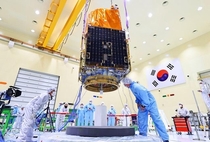Postponed launch due to Corona 19, to Kazakhstan launch site on the 22nd
At half the weight of the Arirang satellite over 1t, the camera performance is similar

This launch is evaluated as a starting point in which the private sector will lead the development of satellites that have been led by the state. The Korea Aerospace Research Institute will jointly develop and transfer technologies with private industries such as the Korea Aerospace Industry (KAI) for a total of five next-generation medium-sized satellites by 2025 to enhance the satellite development capabilities of domestic companies. From Issue 3, the private sector will lead the development in earnest.
The next-generation medium-sized satellite 1 will arrive at the launch site on the 24th, loaded on the Russian freighter’Anton Hope’ at Incheon International Airport this morning. For about two months before launch, final check is made to ensure that there are no problems with fuel injection and projectile assembly process.
After the launch, it climbs up to 497.8km in the air and undergoes an initial test operation for about two months, and then starts the ground observation mission for land and resource management, disaster and disaster response, etc.

The next-generation medium-sized satellite 1 has suffered twists and turns in the aftermath of a novel coronavirus infection (Corona 19) for the past half year. It had already been developed in the first half of last year and was planned to be launched in November. However, as the Russian government stopped direct flights to Incheon and Moscow to prevent the spread of Corona 19, plans were disrupted. This is because Russian scientists who will be in charge of launching the rocket entered Korea and were unable to collaborate. It wasn’t until the end of September that Russian scientists entered Korea via Turkey, but the schedule was delayed for another two weeks as one of them was confirmed by Corona 19. Work resumed from October and safely left for the launch site on this day.
“It is meaningful that the technology secured by Hang Woo-yeon was transferred to the private industry, thereby laying the foundation for the private sector to lead the subsequent development of medium-sized satellites (No. 2-5),” said Lee Chang-yoon, Minister of Science and Technology, a giant public research policy.
